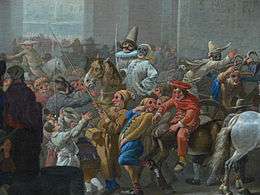Carnival of Aalst
The Carnival of Aalst (Dutch: Carnaval Aalst, local dialect: Carnaval Oilsjt) or Aalst Carnival is a yearly three-day event in the Belgian city of Aalst. It recognised by UNESCO as a Masterpiece of the Oral and Intangible Heritage of Humanity. The carnival is celebrated in the days preceding Ash Wednesday. It is mainly a street happening; the celebrants dance on the city squares and visit café after café.
History
The Aalst carnival has its origin in the Middle Ages. Cavalcades were held since 1851, yet without organisation by the city council. Only the events starting from 1923 are counted as official editions, as the Aalst city council organized the parade from then on. In 2004, at the night between the first and second carnival day the event took heavy damage: the float of the group Geloeif Mè Goed burned down entirely. They had to pay a damage compensation of 1,5 million €, or 50,000 € for each member. The costs ran so high that surrounding companies also suffered economic loss. Years after, many other carnival groups supported the unfortunate members.[1] In 2010 the Aalst carnaval was awarded the status of UNESCO intangible World Heritage.[2]
Course of events
The carnival starts on Sunday and ends on Shrove Tuesday. On the Saturday evening before, in the cultural centre De Werf a humorous city council session takes place, in which Prince Carnival receives the city key and local politicians are mocked with. The session is held in the local dialect (Oilsjters) and not the city council but experienced carnival members take the word.
On Sunday the great carnival parade crosses the streets, a spectacle involving tens of thousands of visitors every year.[3] Over 100 floats are included, and since 1970 the carnival groups are only from Aalst itself. Apart from these large groups also smaller 'loose groups' participate; they lay their focus more on mockery and satire than the decorative aspect. Also these 'small' groups can count as many as 100 members.
The Monday parade has a different atmosphere than the Sunday one; the floats don't follow the strict Sunday order of appearance. In the evening, prizes are awarded based on points given on Sunday. Apart from that, also the yearly Broom Dance by the Gilles of Aalst takes place, followed by the "onion throw". Prince Carnival and party committee members throw onion-sized candies from the balcony of the town hall; some of them include numbers matching with prizes among which one special prize: a golden onion, uniquely designed for that year's Carnival. In the evening, again many town squares are the centre of celebration.
On Tuesday the Stoet van de Voil Jeanetten (Aalst dialect for "Parade of the Dirty Sissies") goes through the streets. In this parade, men walk around in women's clothes with as attributes a bird cage, a herring, fake breasts, corsets, a fur coat, a worn umbrella and a stroller. This tradition originates from the history of Aalst: the lower class was too poor to buy or make a beautiful carnival costume, and for that reason the men put on the old and worn clothes of their wives. In the evening, the traditional puppet burning takes place to end the carnival event. To extend the time until the burning of the giant puppet, the participants whistle and shout aloud, but once the puppet catches fire the carnival comes to its emotional end with a third evening of celebrations.
Since 1953, each year a Prince Carnival is elected; he can reign the city during the entire three-day event. Also Kaiser Carnival plays an important role. To become Kaiser, one needs to be Prince in three prior events.


References
- ↑ De Smedt, Leen (6 Jul 2013). "Aalst laat Geloeif Mè Goed niet in de steek". Het Nieuwsblad. Retrieved 23 Jan 2015.
- ↑ sdg; mtm (16 Nov 2010). "Aalst Carnaval erkend als werelderfgoed". De Standaard (in Dutch). Retrieved 23 Jan 2015.
- ↑ "86e carnavalsstoet uitgereden in Aalst" (in Dutch). VRT. 2 Mar 2014. Retrieved 23 Jan 2015.
External links
| Wikimedia Commons has media related to Carnival of Aalst, Belgium. |
